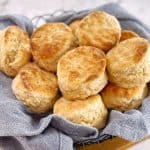
Brown Scones (Wholemeal Scones) with Buttermilk
Brown Scones (Wholemeal Scones) - these scones are a savoury version of traditional buttermilk scones. Great slathered with butter for afternoon tea or dinner!
Servings 14
Calories 170kcal
Ingredients
- 225 g wholemeal self raising flour
- 225 g plain self raising flour (plus extra for dusting)
- 100 g salted butter cold - cubed
- 2 tablespoon finely grated parmesan cheese
- 270 ml buttermilk
- ½ teaspoon fine salt
Instructions
- Preheat oven to 220c/430f.
- Add plain SR flour (225g) and wholemeal SR flour (225g) to a large bowl and mix lightly to combine.
- Add cubed butter (100g) to flour and using your fingertips rub the butter into the flour (or use a pastry cutter as pictured above) until the mixture resembles breadcrumbs.
- Mix in finely grated parmesan (2 tbsp) and fine salt (½ tsp).
- Add buttermilk (270ml/1 cup + 1 tbsp) to flour mixture and mix with a flat bladed knife. For the final few strokes bring the mixture together with your hands. Do not over-knead.
- Turn the dough out onto a well-floured bench/board and knead the dough very lightly (only a few turns) until just smooth, then pat the dough out into an even piece approximately 2½ cm/1" thick.
- Dip a round 6cm/2½″ scone cutter into some extra flour and cut out scones, being careful not to twist the cutter or touch the edges of the scones (see my notes). Lightly push together any remaining dough scraps and repeat.
- Place scones onto a baking tray and bake for 12 - 15 minutes.
Notes
- If you don't have a pastry cutter (I bought mine from the local supermarket) just rub the cubed butter and flour in between your fingers - it's an action as if you were sprinkling something like maybe salt for instance.
- I use fresh grated parmesan for this recipe.
- Don't overwork the scone mixture, you want to mix it/knead it just enough to bring it together. I use my hands for the last few strokes while it's still in the bowl. If not, you will get tough scones.
- Make sure your board is really well-floured, this means that the scones won't stick to the board or the tray when you bake them.
- When you cut out these scones, try not to twist or rotate the cutter at all. If you twist the cutter when pushing down into the dough or when lifting it back out, this will mess up the clean edges you need on your scones to help them rise.
- Likewise, when you are putting them on to the baking tray try not to handle the edges. I use a thin metal cake slice to transfer my raw scones to the tray for baking.
- No buttermilk? My go-to substitute is to add 1 tablespoon of white vinegar or fresh lemon juice to 1 cup (250ml) of whole milk, then leave for 5-10 minutes at room temperature until the mixture looks slightly thickened and curdled. Sounds weird but it works! This link has some more alternatives.
Nutrition
Calories: 170kcal